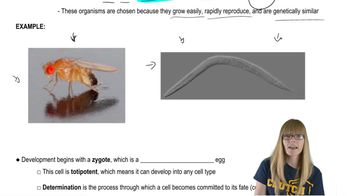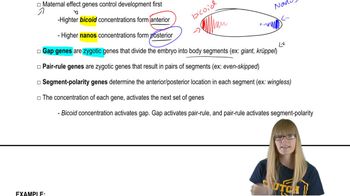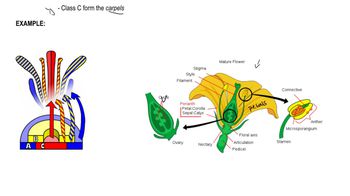Table of contents
- 1. Introduction to Genetics51m
- 2. Mendel's Laws of Inheritance3h 37m
- 3. Extensions to Mendelian Inheritance2h 41m
- 4. Genetic Mapping and Linkage2h 28m
- 5. Genetics of Bacteria and Viruses1h 21m
- 6. Chromosomal Variation1h 48m
- 7. DNA and Chromosome Structure56m
- 8. DNA Replication1h 10m
- 9. Mitosis and Meiosis1h 34m
- 10. Transcription1h 0m
- 11. Translation58m
- 12. Gene Regulation in Prokaryotes1h 19m
- 13. Gene Regulation in Eukaryotes44m
- 14. Genetic Control of Development44m
- 15. Genomes and Genomics1h 50m
- 16. Transposable Elements47m
- 17. Mutation, Repair, and Recombination1h 6m
- 18. Molecular Genetic Tools19m
- 19. Cancer Genetics29m
- 20. Quantitative Genetics1h 26m
- 21. Population Genetics50m
- 22. Evolutionary Genetics29m
14. Genetic Control of Development
Developmental Patterning Genes
Problem 26c
Textbook Question
In land plants, there is an alternation of generations between a haploid gametophyte generation and a diploid sporophytic generation. Both generations are typically multicellular and may be free-living. The male (pollen) and female (embryo sac) gametophytes are the haploid generation of flowering plants.
How would you conduct a screen to identify genes required for male gametophyte development?
 Verified step by step guidance
Verified step by step guidance1
<span>Step 1: Understand the biological context. In flowering plants, the male gametophyte is the pollen grain, which develops from microspores through a process called microsporogenesis and microgametogenesis. Identifying genes involved in this process requires understanding the stages of pollen development.</span>
<span>Step 2: Choose a model organism. Select a plant species that is well-studied and has available genetic resources, such as Arabidopsis thaliana, which is commonly used in plant genetics research.</span>
<span>Step 3: Mutagenize the plant population. Use a mutagen, such as ethyl methanesulfonate (EMS) or T-DNA insertion, to induce random mutations in the plant genome. This will create a population of plants with various genetic mutations.</span>
<span>Step 4: Screen for mutants with defective male gametophyte development. Grow the mutagenized plants and examine their pollen under a microscope. Look for phenotypes such as abnormal pollen morphology, reduced pollen viability, or failure to germinate.</span>
<span>Step 5: Identify and characterize the genes. Once mutants with defective pollen are identified, use genetic mapping or sequencing techniques to determine the location and identity of the mutated genes. Further analysis, such as gene expression studies, can help elucidate the role of these genes in male gametophyte development.</span>
Recommended similar problem, with video answer:
 Verified Solution
Verified SolutionThis video solution was recommended by our tutors as helpful for the problem above
Video duration:
1mPlay a video:
Was this helpful?
Key Concepts
Here are the essential concepts you must grasp in order to answer the question correctly.
Alternation of Generations
Alternation of generations is a reproductive cycle in land plants that involves two distinct multicellular stages: the haploid gametophyte and the diploid sporophyte. The gametophyte produces gametes through mitosis, while the sporophyte produces spores through meiosis. Understanding this cycle is crucial for identifying genes involved in the development of specific generations, such as the male gametophyte.
Recommended video:
Guided course

Alternative DNA Forms
Gametophyte Development
Gametophyte development refers to the processes by which haploid structures, such as pollen in flowering plants, form and mature. This development is influenced by various genetic and environmental factors, and involves cell division, differentiation, and the formation of reproductive organs. Identifying genes that regulate these processes is essential for understanding male gametophyte formation.
Recommended video:
Guided course

Genetics of Development
Gene Screening Techniques
Gene screening techniques, such as mutagenesis, gene expression profiling, and CRISPR-Cas9 gene editing, are methods used to identify and analyze genes involved in specific biological processes. In the context of male gametophyte development, these techniques can help pinpoint mutations or gene expressions that affect gametophyte formation and function, providing insights into the genetic basis of this developmental stage.
Recommended video:
Guided course

Mapping Genes

 11:19m
11:19mWatch next
Master Segmentation Genes with a bite sized video explanation from Kylia Goodner
Start learningRelated Videos
Related Practice



